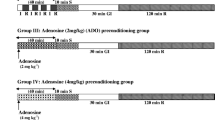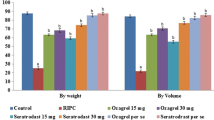Abstract
Remote ischemic preconditioning (RIPC) treatment strategy is a breakthrough in the field of cardiovascular pharmacology as it has the potential to attenuate myocardial ischemia-reperfusion injury. However, the underlying intracellular pathways have not been widely explored. The present study intends to explore the possible role of TRPV1 channels in mediating remote hind limb preconditioning-induced cardioprotection. Remote hind limb preconditioning stimulus (4 cycles in succession) was delivered by tying the blood pressure cuff at the inguinal level of the rat. The Langendorff system was used to perfuse the isolated heart and afterward was subjected to 30 min of global ischemia and 120 min of reperfusion. Sustained ischemia and, thereafter, reperfusion led to cardiac injury that was assessed in terms of infarct size, lactate dehydrogenase (LDH) release, creatine kinase (CK) release, left ventricular end diastolic pressure (LVEDP), left ventricular developed pressure (LVDP), +dp/dtmax, −dp/dtmin, heart rate, rate pressure product, and coronary flow rate. The pharmacological modulators employed included capsaicin as TRPV1 agonist and capsazepine as TRPV1 antagonist. Remote hind limb preconditioning stimulus and capsaicin preconditioning (5 and 10 mg/kg) led to significant reduction in infarct size, LVEDP, LDH release, CK release, and significant improvement in LVDP, +dp/dtmax, −dp/dtmin, heart rate, rate pressure product, and coronary flow rate. However, remote hind limb preconditioning-induced cardioprotective effects were considerably abolished in the presence of capsazepine (2.5 and 5 mg/kg). This indicates that remote hind limb preconditioning stimulus possibly activates TRPV1 channels to produce cardioprotective effects.




Similar content being viewed by others
References
Almeida V, Peres FF, Levin R, Suiama MA, Calzavara MB, Zuardi AW, Hallak JE, Crippa JA, Abílio VC (2014) Effects of cannabinoid and vanilloid drugs on positive and negative-like symptoms on an animal model of schizophrenia: the SHR strain. Schizophr Res 153:150–159
Bevan S, Hothi S, Hughes G, James IF, Rang HP, Shah K, Walpole CS, Yeats JC (1992) Capsazepine: a competitive antagonist of the sensory neurone excitant capsaicin. Br J Pharmacol 107:544–552
Boillat A, Alijevic O, Kellenberger S (2014) Calcium entry via TRPV1 but not ASICs induces neuropeptide release from sensory neurons. Mol Cell Neurosci 61:13–22
Diwan V, Kant R, Jaggi AS, Singh N, Singh D (2008) Signal mechanism activated by erythropoietin preconditioning and remote renal preconditioning-induced cardioprotection. Mol Cell Biochem 315:195–201
Eckert P, Schnackerz K (1991) Ischemic tolerance of human skeletal muscle. Ann Plast Surg 26:77–84
Gao F, Liang Y, Wang X, Lu Z, Li L, Zhu S, Liu D, Yan Z, Zhu Z (2014) TRPV1 activation attenuates high-salt diet-induced cardiac hypertrophy and fibrosis through PPAR-δ upregulation. PPAR Res 2014:491963
Gao Y, Song J, Chen H, Cao C, Lee C (2015) TRPV1 activation is involved in the cardioprotection of remote limb ischemic postconditioning in ischemia-reperfusion injury rats. Biochem Biophys Res Commun 463:1034–1039
Guzy PM (1977) Creatine phosphokinase-MB (CPK-MB) and the diagnosis of myocardial infarction. West J Med 127:455–460
Hanson SM, Newstead S, Swartz KJ, Sansom MS (2015) Capsaicin interaction with TRPV1 channels in a lipid bilayer: molecular dynamics simulation. Biophys J 108:1425–1434
Harper AG, Brownlow SL, Sage SO (2009) A role for TRPV1 in agonist-evoked activation of human platelets. J Thromb Haemost 7(2):330–8
Hazan A, Kumar R, Matzner H, Priel A (2015) The pain receptor TRPV1 displays agonist-dependent activation stoichiometry. Sci Rep 5:12278
Herscher LL, Siegel RJ, Said JW, Edwalds GM, Moran MM, Fishbein MC (1984) Distribution of LDH-1 in normal, ischemic, and necrotic myocardium. An immunoperoxidase study. Am J Clin Pathol 81:198–203
Inoue R, Jensen LJ, Shi J, Morita H, Nishida M, Honda A, Ito Y (2006) Transient receptor potential channels in cardiovascular function and disease. Circ Res 21(99):119–131
Kant R, Diwan V, Jaggi AS, Singh N, Singh D (2008) Remote renal preconditioning-induced cardioprotection: a key role of hypoxia inducible factor-prolyl 4-hydroxylases. Mol Cell Biochem 312:25–31
Kaszas K, Keller JM, Coddou C, Mishra SK, Hoon MA, Stojilkovic S, Jacobson KA, Iadarola MJ (2012) Small molecule positive allosteric modulation of TRPV1 activation by vanilloids and acidic pH. J Pharmacol Exp Ther 340:152–160
Khatibi NH, Jadhav V, Charles S, Chiu J, Buchholz J, Tang J, Zhang JH (2011) Capsaicin pre-treatment provides neurovascular protection against neonatal hypoxic-ischemic brain injury in rats. Acta Neurochir Suppl 111:225–230
King J (1959) A routine method for the estimation of lactic dehydrogenase activity. J Med Lab Technol 16:265–272
Langendorff O (1885) Untersuchungen amuber lebenderer saugethierherzen. Pfluger. Arch. Gesmate.Physio 61:291–332
Li D, Li NS, Chen QQ, Guo R, Xu PS, Deng HW, Li YJ (2008) Calcitonin gene-related peptide-mediated cardioprotection of postconditioning in isolated rat hearts. Regul Pept 147:4–8
Lu MJ, Chen YS, Huang HS, Ma MC (2014) Hypoxic preconditioning protects rat hearts against ischemia-reperfusion injury via the arachidonate12-lipoxygenase/transient receptor potential vanilloid 1 pathway. Basic Res Cardiol 109:414
Newson PN, van den Buuse M, Martin S, Lynch-Frame A, Chahl LA (2014) Effects of neonatal treatment with the TRPV1 agonist, capsaicin, on adult rat brain and behaviour. Behav Brain Res 272:55–65
Nishio R, Sasayama S, Matsumori A (2002) Left ventricular pressure-volume relationship in a murine model of congestive heart failure due to acute viral myocarditis. J Am Coll Cardiol 40:1506–1514
Node K, Kitakaze M, Sato H, Minamino T, Komamura K, Shinozaki Y, Mori H, Hori M (1997) Role of intracellular Ca2+ in activation of protein kinase C during ischemic preconditioning. Circulation 96:1257–1265
Nozadze I, Tsiklauri N, Gurtskaia G, Tsagareli MG (2016) Role of thermo TRPA1 and TRPV1 channels in heat, cold, and mechanical nociception of rats. Behav Pharmacol 27:29–36
Peng J, Li YJ (2010) The vanilloid receptor TRPV1: role in cardiovascular and gastrointestinal protection. Eur J Pharmacol 627:1–7
Preus M, Bhargava AS, Khater AE, Günzel P (1988) Diagnostic value of serum creatine kinase and lactate dehydrogenase isoenzyme determinations for monitoring early cardiac damage in rats. Toxicol Lett 42:225–233
Randhawa PK, Jaggi AS (2015) TRPV1 and TRPV4 channels: potential therapeutic targets for ischemic conditioning-induced cardioprotection. Eur J Pharmacol 746:180–185
Randhawa PK, Jaggi AS (2016) Gadolinium and ruthenium red attenuate remote hind limb preconditioning-induced cardioprotection: possible role of TRP and especially TRPV channels. Naunyn Schmiedeberg’s Arch Pharmacol 389(8):887–896
Reichelt ME, Willems L, Hack BA, Peart JN, Headrick JP (2009) Cardiac and coronary function in the Langendorff-perfused mouse heart model. Exp Physiol 94:54–70
Serizawa T, Vogel WM, Apstein CS, Grossman W (1981) Comparison of acute alterations in left ventricular relaxation and diastolic chamber stiffness induced by hypoxia and ischemia. Role of myocardial oxygen supply-demand imbalance. J Clin Invest 68(1):91–102
Sharif-Naeini R, Ciura S, Zhang Z, Bourque CW (2008) Contribution of TRPV channels to osmosensory transduction, thirst, and vasopressin release. Kidney Int 73:811–815
Sharma R, Randhawa PK, Singh N, Jaggi AS (2016a) Possible role of thromboxane A2 in remote hind limb preconditioning-induced cardioprotection. Naunyn Schmiedeberg’s Arch Pharmacol 389:1–9
Sharma R, Randhawa PK, Singh N, Jaggi AS (2016b) Possible role of thromboxane A2 in remote hind limb preconditioning-induced cardioprotection. Naunyn Schmiedeberg’s Arch Pharmacol 389(1):1–9
Shintani Y, Node K, Asanuma H, Sanada S, Takashima S, Asano Y, Liao Y, Fujita M, Hirata A, Shinozaki Y, Fukushima T, Nagamachi Y, Okuda H, Kim J, Tomoike H, Hori M, Kitakaze M (2004) Opening of Ca2+-activated K+ channels is involved in ischemic preconditioning in canine hearts. J Mol Cell Cardiol 37:1213–1218
Singh B, Randhawa PK, Singh N, Jaggi AS (2016) Investigations on the role of leukotrienes in remote hind limb preconditioning-induced cardioprotection in rats. Life Sci 152:238–243
Vivaldi MT, Kloner RA, Schoen FJ (1985) Triphenyltetrazolium staining of irreversible ischemic injury following coronary artery occlusion in rats.Am J Pathol 121(3):522–30
Vriens J, Appendino G, Nilius B (2009) Pharmacology of vanilloid transient receptor potential cation channels. Mol Pharmacol 75:1262–1279
Wang L, Wang DH (2005) TRPV1 gene knockout impairs postischemic recovery in isolated perfused heart in mice. Circulation 112:3617–3623
Wei Z, Wang L, Han J, Song J, Yao L, Shao L, Sun Z, Zheng L (2009) Decreased expression of transient receptor potential vanilloid 1 impairs the postischemic recovery of diabetic mouse hearts. Circ J 73:1127–1132
Wever KE, Warlé MC, Wagener FA, van der Hoorn JW, Masereeuw R, van der Vliet JA, Rongen GA (2011) Remote ischaemic preconditioning by brief hind limb ischaemia protects against renal ischaemia-reperfusion injury: the role of adenosine. Nephrol Dial Transplant 26:3108–3117
White SK, Frohlich GM, Sado DM, Maestrini V, Fontana M, Treibel TA, Tehrani S, Flett AS, Meier P, Ariti C, Davies JR, Moon JC, Yellon DM, Hausenloy DJ (2015) Remote ischemic conditioning reduces myocardial infarct size and edema in patients with ST-segment elevation myocardial infarction. JACC Cardiovasc Interv (1 Pt B):178–188
Yang D, Luo Z, Ma S, Wong WT, Ma L, Zhong J, He H, Zhao Z, Cao T, Yan Z, Liu D, Arendshorst WJ, Huang Y, Tepel M, Zhu Z (2010) Activation of TRPV1 by dietary capsaicin improves endothelium-dependent vasorelaxation and prevents hypertension. Cell Metab 12(2):130–141
Yao X, Li Y, Tao M, Wang S, Zhang L, Lin J, Xia Z, Liu HM (2015) Effects of glucose concentration on propofol cardioprotection against myocardial ischemia reperfusion injury in isolated rat hearts. J Diabetes Res 2015:592028
Zahner MR, Li DP, Chen SR, Pan HL (2003) Cardiac vanilloid receptor 1-expressing afferent nerves and their role in the cardiogenic sympathetic reflex in rats. J Physiol 551:515–523
Zheng LR, Zhang YY, Han J, Sun ZW, Zhou SX, Zhao WT, Wang LH (2015) Nerve growth factor rescues diabetic mice heart after ischemia/reperfusion injury via up-regulation of the TRPV1 receptor. J Diabetes Complicat 29:323–328
Zhong B, Wang DH (2009) Protease-activated receptor 2-mediated protection of myocardial ischemia-reperfusion injury: role of transient receptor potential vanilloid receptors. Am J Physiol Regul Integr Comp Physiol 297:R1681–R1690
Acknowledgment
The authors are thankful to the Department of Science and Technology F. No. SB/SO/HS/0004/2013, New Delhi, for providing us financial assistance and the Department of Pharmaceutical Sciences and Drug Research, Punjabi University, Patiala, India, for supporting us.
Author information
Authors and Affiliations
Corresponding author
Ethics declarations
The experimental protocol was approved by the Institutional Animal Ethics Committee, and care of the animals was carried out as per the guidelines of the Committee for the Purpose of Control and Supervision of Experiments on Animals (CPCSEA), Ministry of Environment and Forest, Government of India (Reg. No. 107/99/CPCSEA/2013-37).
Rights and permissions
About this article
Cite this article
Randhawa, P.K., Jaggi, A.S. Investigating the involvement of TRPV1 ion channels in remote hind limb preconditioning-induced cardioprotection in rats. Naunyn-Schmiedeberg's Arch Pharmacol 390, 117–126 (2017). https://doi.org/10.1007/s00210-016-1311-x
Received:
Accepted:
Published:
Issue Date:
DOI: https://doi.org/10.1007/s00210-016-1311-x




